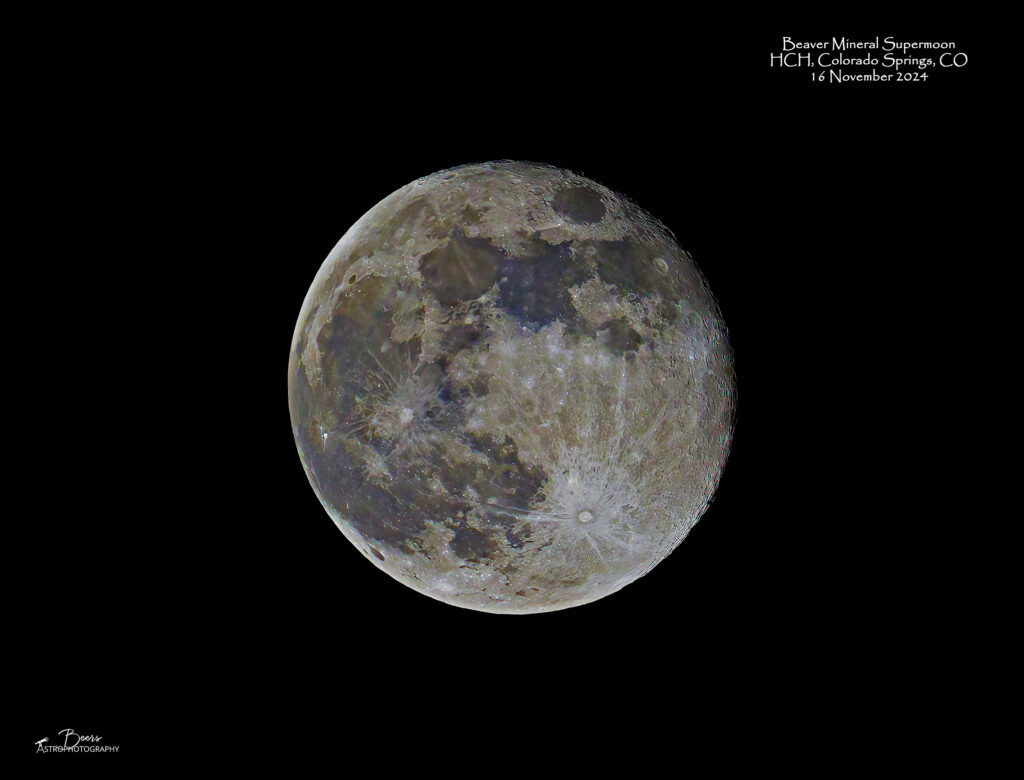
November’s Beaver Supermoon processed as a Mineral Moon; captured from HCH, Colorado Springs, Colorado on 16 September 2024
Fun facts
The Beaver Supermoon: The Beaver Moon reaches peak illumination on Friday, November 15, at 4:29 P.M. EST. It is the final supermoon of four consecutive supermoons of the year! This means that it will appear bigger and brighter than normal!
For decades, the Almanac has referenced the monthly full Moons with names tied to early Native American, Colonial American, and European folklore. Traditionally, each full Moon name was applied to the entire lunar month in which it occurred and through all of the Moon’s phases—not only the full Moon.
Why the “Beaver” Moon? This is the time of year when beavers begin to take shelter in their lodges, having laid up sufficient food stores for the long winter ahead. During the fur trade in North America, it was also the season to trap beavers for their thick, winter-ready pelts.
{From: https://www.almanac.com/full-moon-november}
The Mineral Moon: The Moon is usually seen in subtle shades of gray or yellow. The different colors are recognized to correspond to real differences in the chemical composition of the lunar surface. The blue tones reveal areas rich in ilmenite, which contains iron, titanium and oxygen, mainly titanium, while the orange and purple colors show regions relatively poor in titanium and iron.
The Moon Geology: The geology of the Moon (sometimes called selenology, although the latter term can refer more generally to “lunar science”) is quite different from that of Earth. The Moon lacks a true atmosphere, and the absence of free oxygen and water eliminates erosion due to weather. Instead, the surface is eroded much more slowly through the bombardment of the lunar surface by micrometeorites. It does not have any known form of plate tectonics, it has a lower gravity, and because of its small size, it cooled faster. In addition to impacts, the geomorphology of the lunar surface has been shaped by volcanism, which is now thought to have ended less than 50 million years ago. The Moon is a differentiated body, with a crust, mantle, and core.
Geological studies of the Moon are based on a combination of Earth-based telescope observations, measurements from orbiting spacecraft, lunar samples, and geophysical data. Six locations were sampled directly during the crewed Apollo program landings from 1969 to 1972, which returned 382 kilograms (842 lb) of lunar rock and lunar soil to Earth. In addition, three robotic Soviet Luna spacecraft returned another 301 grams (10.6 oz) of samples, and the Chinese robotic Chang’e 5 returned a sample of 1,731 g (61.1 oz) in 2020.
The Moon is the only extraterrestrial body for which we have samples with a known geologic context. A handful of lunar meteorites have been recognized on Earth, though their source craters on the Moon are unknown. A substantial portion of the lunar surface has not been explored, and several geological questions remain unanswered.
Elements known to be present on the lunar surface include, among others, oxygen (O), silicon(Si), iron (Fe), magnesium (Mg), calcium (Ca), aluminium (Al), manganese (Mn) and titanium (Ti). Among the more abundant are oxygen, iron and silicon. The oxygen content is estimated at 45% (by weight). Carbon (C) and nitrogen (N) appear to be present only in trace quantities from deposition by solar wind.
{ A great deal more information about the geology and landscape of the moon is at: https://en.wikipedia.org/wiki/Geology_of_the_Moon }
Equipment
Imaging Equipment: Tamron SP 150-600mm f/5-6.3 Di VC USD G2 for Canon EF lens; Canon EOS 5DS R camera on tripod
Capture & processing notes
Capture & processing notes: Inspired by Ann Chavtur’s processing of a mineral moon last month and by Patty’s comment during dinner on how spectacular Ann’s image was, I came home from dinner and set up the Canon 5DSR with the Tamron 150-600mm lens on a tripod and captured a few photos of the Beaver Supermoon (at 99% full on Saturday night)! I captured a few images and then looked up the email from Ann on the processing technique. She didn’t have the specifics in her email, so I Googled in. Saturday evening I read through a BBC Sky at Night article (https://www.skyatnightmagazine.com/astrophotography/astrophoto-tips/create-a-mineral-moon-astrophoto and on Sunday morning on the spin bike watched a SarahMaths Astro YouTube video https://www.youtube.com/watch?v=4TZH_4Lx_mQ. I combined the two sources of information into my own workflow that I used to produce the image in this gallery.
Sequence Plan: Single exposure captured with Canon 5DSR on tripod, Tamron 150-600mm lens; ISO400, f/11, 1/400 second
Processing: Processed in LR/PS using Mineral Moon processing steps combined from SarahMaths Astro YouTube video and BBC Sky at Night Magazine article referenced above.
